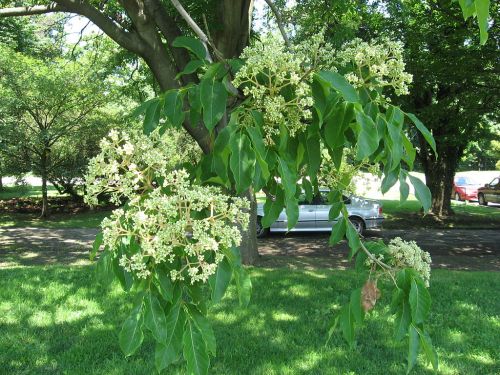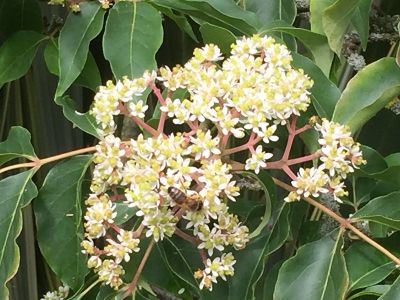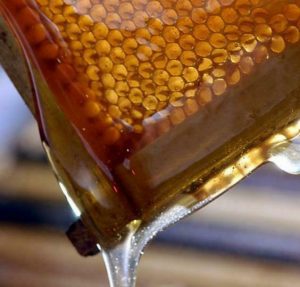Tetradium daniellii (syn. Tetradium hupehensis) belongs to Tetradium, a genus of trees in the family Rutaceae, occurring in temperate to tropical east Asia. It is also known as Euodia, Evodia, Korean Evodia or Bee bee tree. Because this tree is LOVED by bees. Read more to see how evodia honey is and how one can get it.
Tetradium daniellii, named after the British army surgeon and botanist William Freeman Daniell, originates from southwestern China and Korea, grows slowly to be over 12 metres long and up to 4 to 8 metres wide, when fully mature. Suitable for both small and large gardens. It loves full sun, but it can also withstand temperatures down to -15°C (5°F). (though not a fan of harsh winds). It likes fertile, well drained soil and has no pests or diseases (quite amazing!).
 Tetradium daniellii – picture credit Chhe (talk) via Commons Wikimedia
Tetradium daniellii – picture credit Chhe (talk) via Commons Wikimedia
Evodia tree is distantly related to citrus, very attractive to bees and butterflies, and offers berries to birds. It casts light shade, making it a good specimen tree for a lawn.
Some of its characteristics include:
The bark is smooth gray, like that of a beech tree. Specialists say minimal pruning is required, in late winter or early spring, when the tree is dormant. Other specialists say there is no need for pruning, unless you need to change its shape.
The leaves resemble the foliage of an ash tree. They are deciduous – pinnate, up to 40 cm (16 in) or more long, each with up to 11 ovate leaflets. Oval or lance-shaped, glossy, dark-green leaflets in summer turn to various shades of yellow and russet tones in autumn.
 picture credit cpmkutty via flickr.com, under CC
picture credit cpmkutty via flickr.com, under CC
Flowers: The tree blooms from an early age and is fast growing. Flowers cover the tree in late July and August with masses of large, flat white to gray clusters of miniature white flowers, produced in domed, terminal corymbs to 15cm (6in) across. The blossoms are quite aromatic and have a pleasant scent which attracts beneficial pollinators.
These flowers are particularly valued when few other tree-size plants are flowering. This is why it attracts large numbers of bees and it’s sought after by beekeepers as a source of late summer honey.
Seeds: The flowers produce clusters of seed that is present from late August through November. The seeds start as bright red capsules that when fully ripe open to expose shiny black buckshot seeds as Autumn progresses. Birds love them.
Beekeepers should consider having one Evodia tree in their backyard. Tolerant and adaptable, Tetradium daniellii can be successfully grown in most soils, as long as they are well-drained, in full sun to dappled shade. Considered disease and pest free, this cultivar is virtually indestructible. Not only that this ornamental tree does not require any special treatment to thrive, it also needs no pruning to keep its shape. Routine removal of any damaged or dead growth will keep this cultivar healthy and great-looking. Plant it alongside evergreen shrubs to accentuate its umbrella-like habit.

How is evodia honey?
By appearance, evodia honey is very similar to locust honey, but it has a more fruit-like taste and it doesn’t crystallize over time. From a therapeutic point of view, this type of honey works best with walnuts, especially at regulating blood pressure.
When it comes to quantity, evodia honey has no competition. It surpasses linden and acacia, especially due to the humid climate of southern regions when it flowers multiple times, even in October.
However, this quantity of honey depends a lot on how the tree is cared of. In winter during very low temperatures, young trees should be protected with special cloths/plastic wraps, until they are 2, 3 years old. The humidity of the soil it is also important. Consider irrigation if the climate is too dry and you want high amounts of honey.
In favorable conditions one hectare of Evodia tree can produce up to 6 tons of honey! Well, in the honey industry, when one gets 2, 3 tons it is considered extraordinary!
! There are people saying that evodia honey has high spiritual purifying properties.
Where can we buy evodia honey from?
Hard to tell. I could not find it at the online shops and some beekeepers told me that they won’t harvest it. They leave it for the bees as food during the winter season.
If you see somewhere please leave a comment here and let as all know.
You may also be interested in:
• Honey and walnuts health benefits: treat anemia, stomach ulcers, high blood pressure. And make a reliable aphrodisiac!
